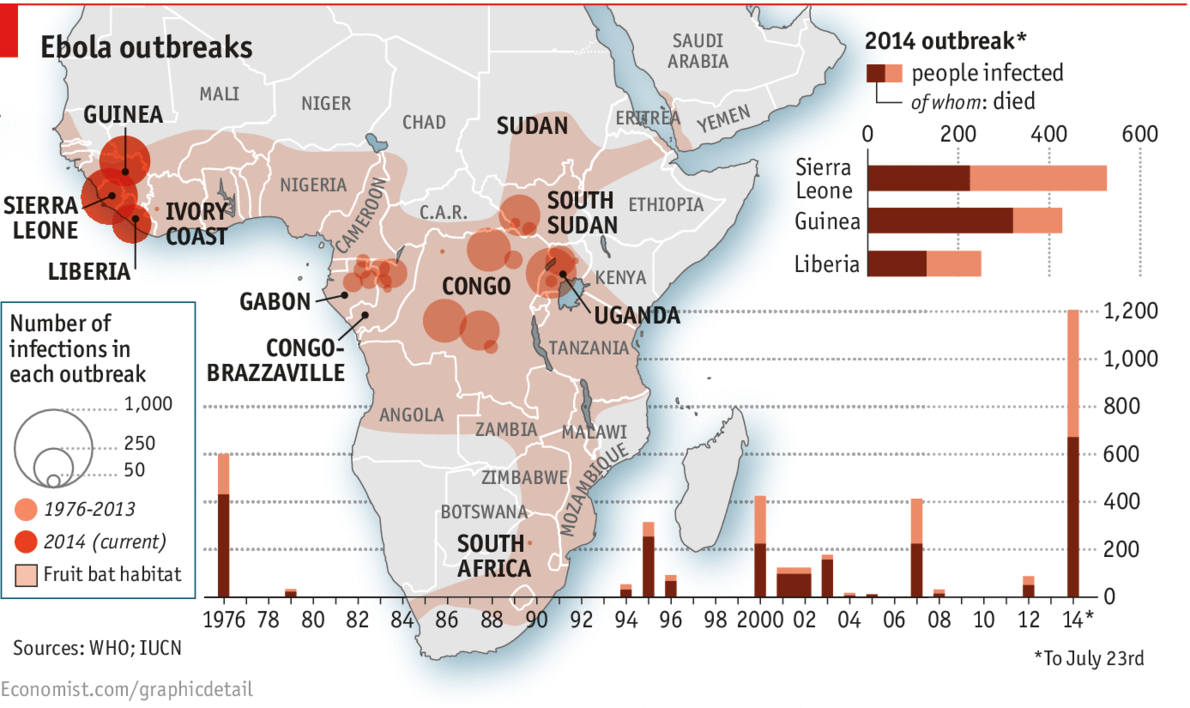Dear readers!
From the title of my blog you probably guessed that the news I
described below is about one of the most dangerous epidemic disease called
Ebola. After reading this blog you will learn
what Ebola is, how and where it has spread, how many people are affected by
this disease to date, and how to protect yourself from this disease.
Enjoy reading!
Ebola as pandemic disease
New wave of ebola pandemic broke out in March of this
year in the West African countries: Guinea, Sierra Leone and Liberia (figure 1)
and reached even America, particularly Texas state. This outbreak
poses a high mortal danger today. As World Health Organization (WHO) reports there
is a high risk of fatality (about 50%) among infected patients and this number
will presumably increase up to 90%.
If West Africa does not quickly take control of the
outbreak of Ebola fever, the disease can become permanent in this region, spreading
as well as malaria or flu. According to the Centers for Disease Control and
Prevention (CDC) the number of victims of the Ebola virus has already reached
at least 3,000 people and if nothing will be done this number may increase to
1,4 million by January of the 2015.
 |
| figure 1. The number of infected and died people from Ebola virus in the West African countries |
So,
to imagine the growing threat of Ebola let’s define what Ebola is and how it
behaves and how humanity can defend against it.
What is Ebola disease and how does it infect people?
Ebola is a disease that is caused by the virus
called Ebolavirus. To understand how Ebolavirus infects the cell, let’s
imagine that virus is a microscopic bad guy whose name is Ebola and the human body
is a building in which rooms are body cells. Each room has an alarm system which
is protein called interferon that detects the entrance of foreign individuals and block the door, so no
one can leave this room and eventually dye. However, Ebola is very tricky, he enters the room and deactivates the
alarm system, thus nothing interferes him to begin his activity. Ebola comes to
the computer that contains all important information about how this building
was made and inserts a memory stick. The
information inside of that memory stick can change the settings of that
computer and make many clones of Ebola through the special printer. In this
case computer is a human DNA that carries the essential genetic information of
our organism and it can be changed by the viral RNA which is the memory stick. This
virus begin to multiply and as the space in the cell is limited viruses create
so much pressure inside the host cell that it explodes. In a result, viruses
are spread over the whole body and cause variety of inflammations and bleeding.
Where did Ebola come from?
First Ebola virus was found in 1976 in two regions
simultaneously, namely Sudan and Yambuku, Democratic Republic of Congo (DRC). Yambuku was located close to the river called Ebola and this is why virus acquired such name.
 |
| Figure 2 The RNA of Ebolavirus found in 1976 |
What are the symptoms of Ebola disease?
People that were infected by Ebolavirus have the
following symptoms:
- the sudden fever
- severe weakness
- pain in muscle
- headache
- sore throat
Additionally, these symptoms can be accompanied by vomiting,
diarrhea, rash, impairment of kidney and liver function, internal and external
bleedings.
Is there any cure against Ebola?
Actually, today no effective cure was created against
Ebolavirus. However, according to Marie-Paule Kieny, Assistant Director
General of the World Health Organisation (WHO) vaccine is going to be prepared
and will be
available to countries affected by the epidemic by 2015.
How can people protect themselves?
Fortunately, Ebolavirus cannot be transmitted by
airborne droplets that is why people cannot be infected by inhaling the air
containing these viruses. However, Ebola easily spreads via unprotected direct
contact with blood and variety of internal secretions of an infected person as
well as through the objects to which person touches. So to prevent the
infection by Ebola people should:
- avoid the contact with infected people
- follow general rules of hygiene (to wash hands with soap after handling something)
- avoid contact with the objects that infected patient may handle
- avoid contact with animals that can be a carrier of Ebolavirus
- not eat the meat prepared from infected animals
If you are interested about Ebola fever the video below will give you some additional information.
Dear readers, I hope this information was useful enough for you and you will take precautions described above
Reference
"AmeriCares:
Emergency Team & More Supplies Arrive on Ebola Front Lines."
AmeriCaresorg News and Press. http://www.americares.org/who-we-are/newsroom/news/ebola-outbreak-urgent-deliveries-medicines-protective-gear-west-africa.html?gclid=CJ6e-ebHi8ECFSOzcgoda3wAbg
(accessed October 7, 2014).
ScienceDaily.
"Ebola protein blocks early step in body's counterattack on virus."
ScienceDaily. http://www.sciencedaily.com/releases/2014/08/140813130044.htm
(accessed October 7, 2014).
"Ebola
virus disease." WHO. http://www.who.int/mediacentre/factsheets/fs103/en/
(accessed October 5, 2014).
The Economist
Newspaper. "Ebola's spread." The Economist. http://www.economist.com/blogs/graphicdetail/2014/07/daily-chart-22
(accessed October 6, 2014).
Wikimedia
Foundation. "Ebolavirus." Wikipedia. http://en.wikipedia.org/wiki/Ebolavirus
(accessed October 5, 2014).
Wikimedia
Foundation. "Portal:Viruses/Selected picture." Wikipedia. http://en.wikipedia.org/wiki/Portal:Viruses/Selected_picture
(accessed October 7, 2014).
Centers for
Disease Control and Prevention. "Prevention." Centers for Disease
Control and Prevention. http://www.cdc.gov/vhf/ebola/prevention/index.html
(accessed October 5, 2014).
The Editors of
Encyclopædia Britannica. "interferon (biochemistry)." Encyclopedia
Britannica Online. http://www.britannica.com/EBchecked/topic/290230/interferon
(accessed October 7, 2014)
"Why Ebola
is so dangerous." BBC News. http://www.bbc.com/news/world-africa-26835233
(accessed October 5, 2014)
YouTube.
"Ebola 'an international emergency' - BBC News." YouTube.
http://www.youtube.com/watch?v=gLeCQaS4SUA (accessed October 7, 2014).
Independent
Digital News and Media. "Ebola virus: Vaccine 'should be ready for 2015',
WHO says, as GSK plays down timing ." The Guardian. http://www.independent.co.uk/news/world/africa/ebola-outbreak-vaccine-should-be-ready-for-2015-who-says-as-gsk-plays-down-timing-9659754.html
(accessed October 7, 2014).
"Ebola in
America: What You Need to Know About the Virus - weather.com." The Weather
Channel. http://www.weather.com/health/ebola-america-what-you-need-know-about-virus-20140805
(accessed October 6, 2014).
No comments:
Post a Comment